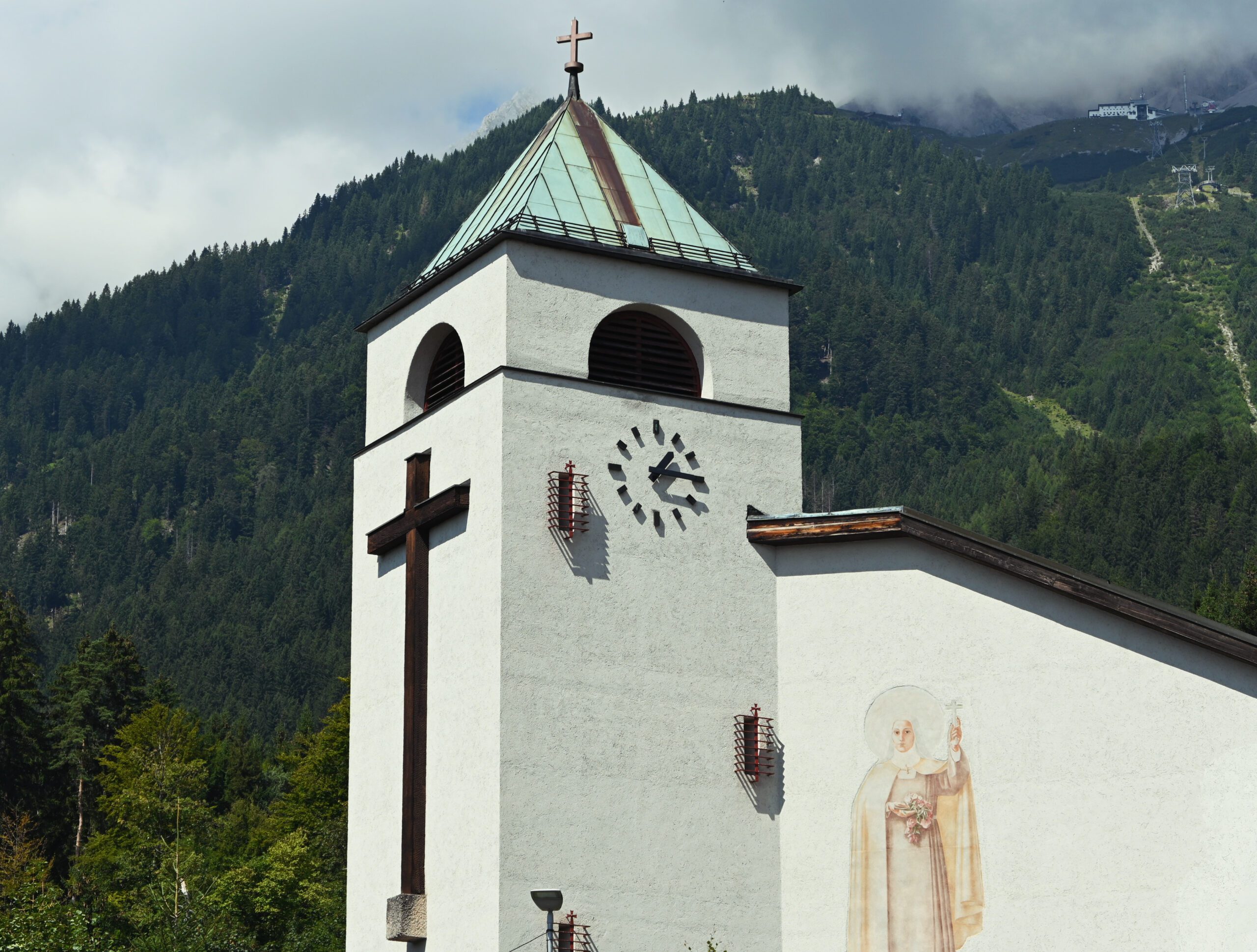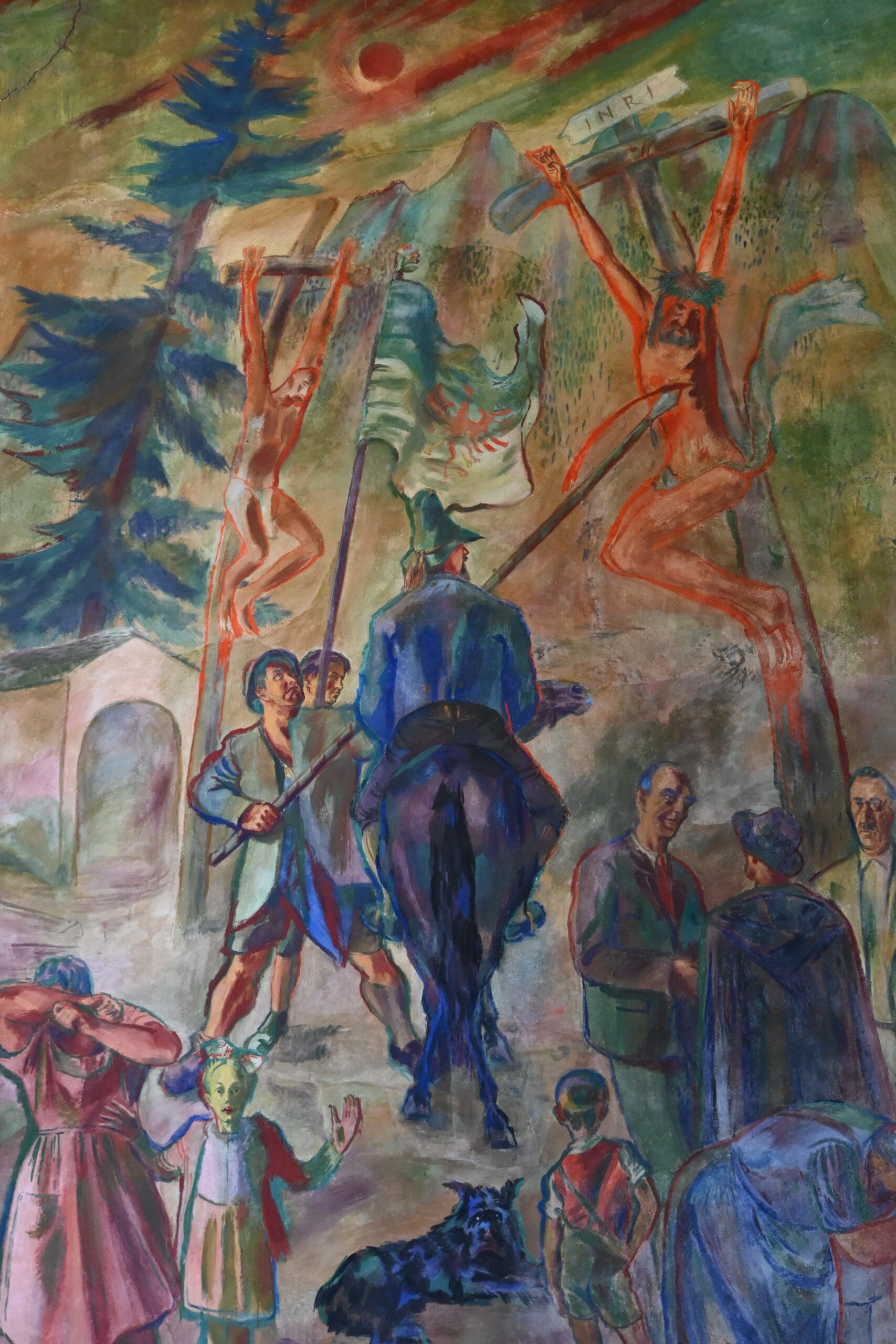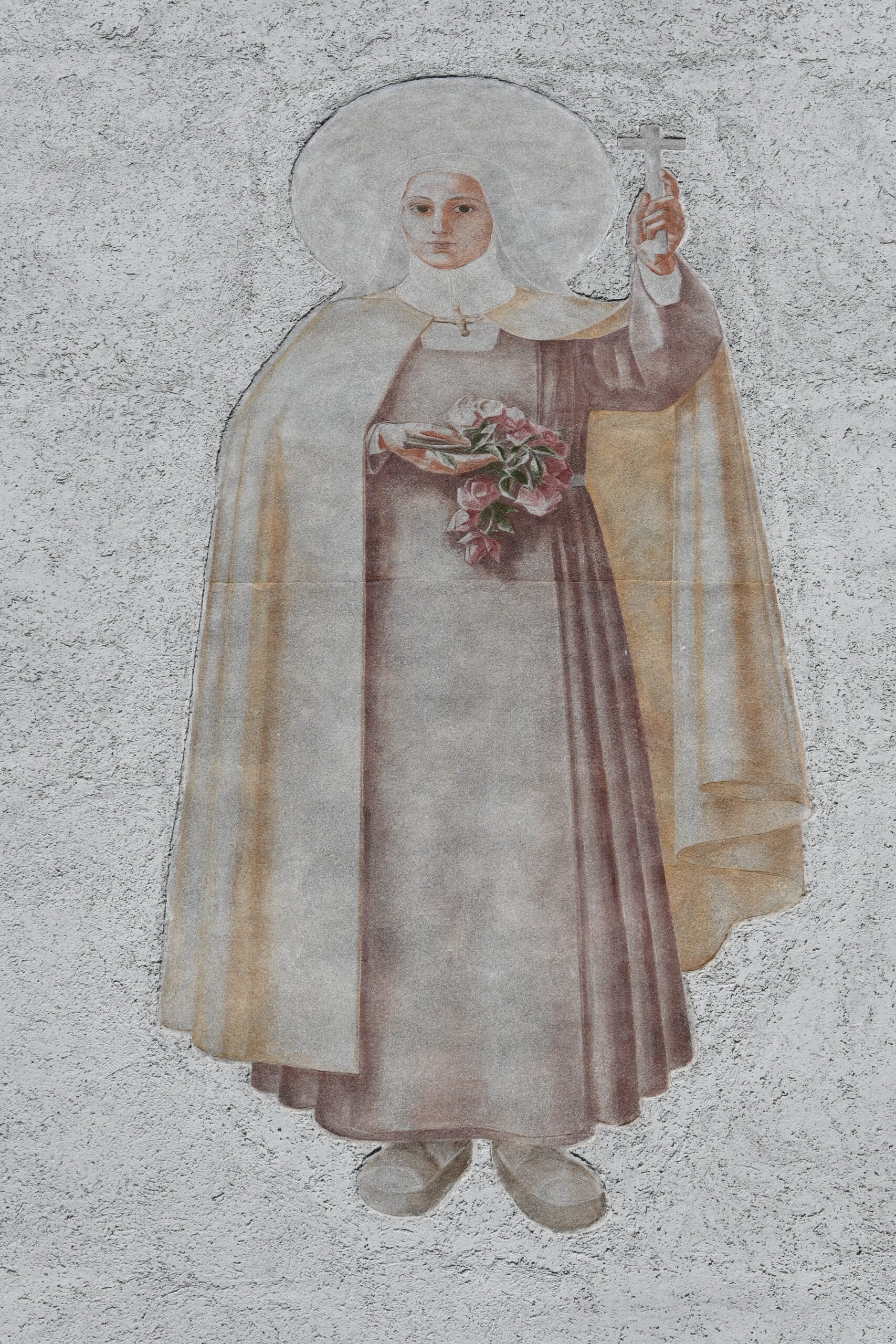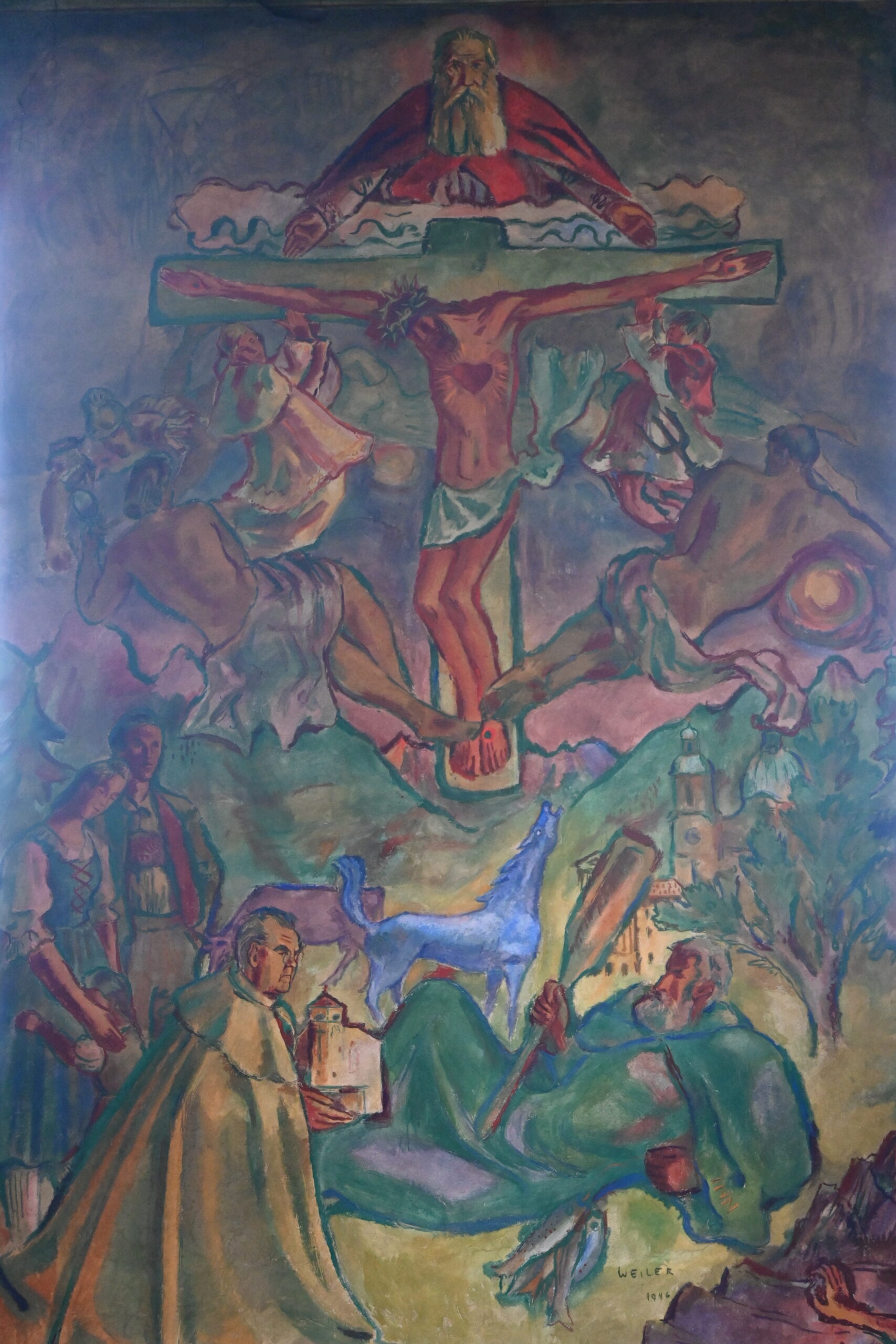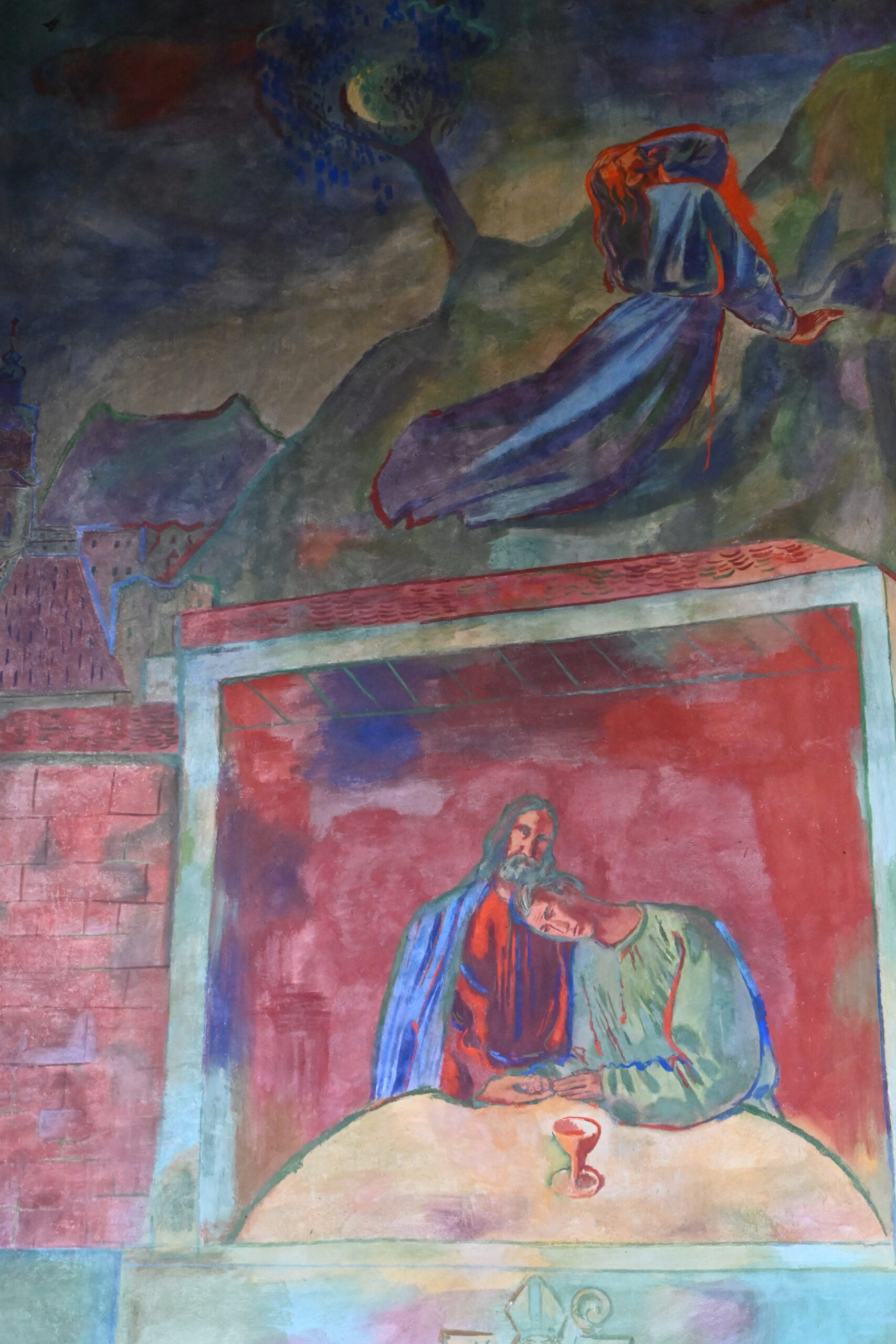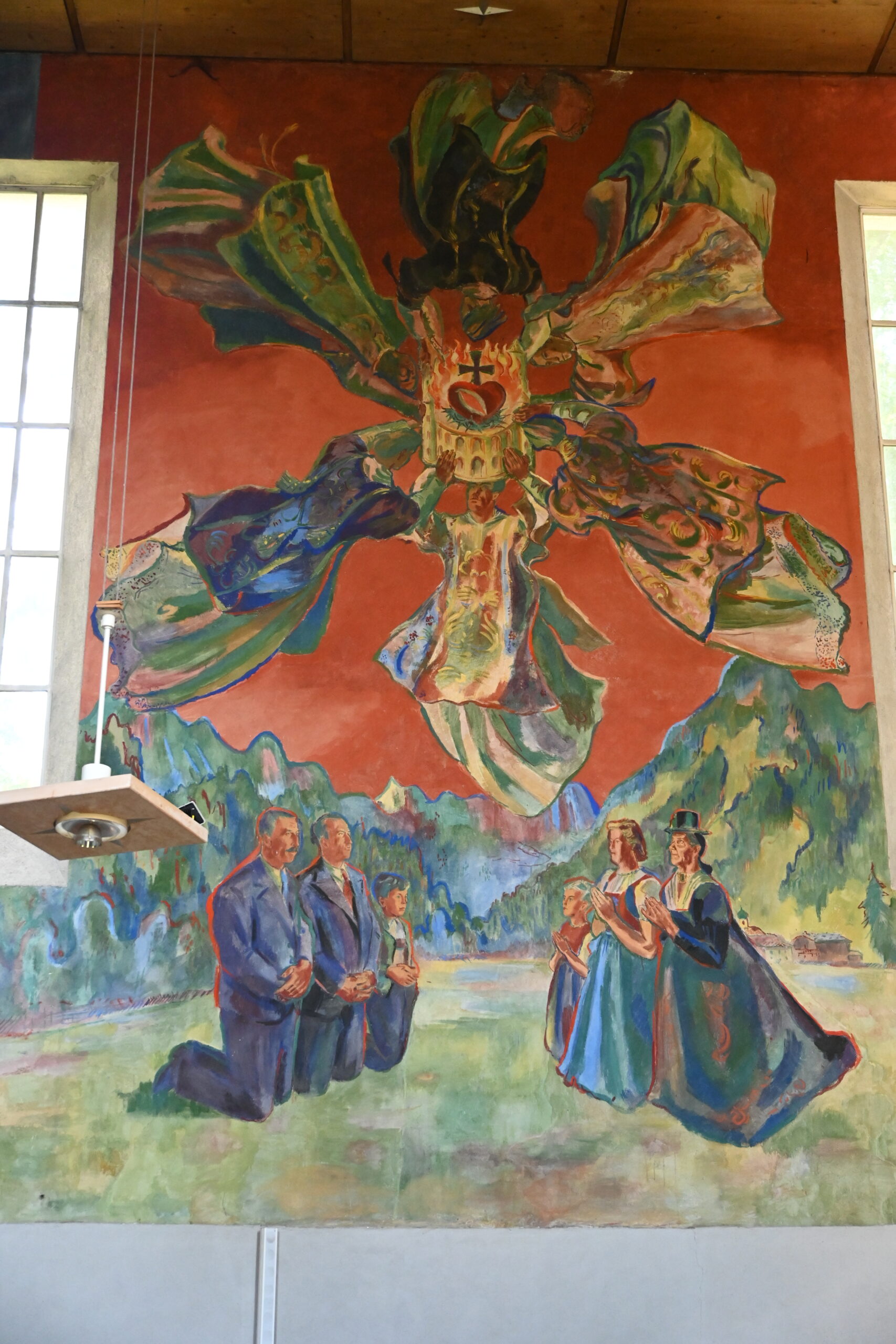Theresienkirche
Gramartstraße 4
Worth knowing
Hoch über Innsbruck befindet sich die Wallfahrtskirche zur Heiligen Theresia vom Kinde Jesu. Der private Verein Mariabrunn built a chapel around a relic and an image of St Theresa in the 1920s. Theresa of Lisieux had died of tuberculosis only a few years earlier after a short but all the more pious life and had been canonised by Pius X at lightning speed. The large number of pilgrims asking St Theresa for help made it necessary to build a church.
In 1931, the association organised a competition. The Upper Austrian architect Wilhelm Stigler (1903 - 1976), who already had his own office on Claudiaplatz in his early 20s, surprisingly won with his design against masters such as Clemens Holzmeister and Franz Baumann. However, as his project plan exceeded the meagre financial resources available for construction in the post-war period, Siegfried Thurner's more economical design was realised. The cubic building was designed in the New Objectivity style, in keeping with the spirit of the times. The numberless clock, which adorns the striking tower, was a favourite stylistic element. The interior of the church is particularly worth seeing. In 1935, the artist Ernst Nepo (1895 - 1971) created the fresco of St Theresa above the entrance. The depiction already anticipated the artistic style desired under the National Socialist regime, which was to dominate Austria after 1938 until the end of the war. After the war, Nepo's involvement in the completion of the church was no longer desired, as the early National Socialist had already had a picture of the Führer made in 1937, which had been presented to him personally by the Tyrolean Nazi women's organisation for his birthday.
In his place, the Tyrolean artist Max Weiler (1910 - 2001) continued the work from 1946 onwards in order to see the nave of the church decorated in time for the 150th anniversary of the renewal of the Sacred Heart Society of 1796 in the province of Tyrol. The artist, who was still less well-known at the time, managed to complete four paintings. "Die Verehrung des Herzens Jesu“, „Die Herz-Jesu-Sonne“, „Johannesminne und Ölberg“ and „Der Lanzenstich" could be completed before it came to a scandal. The image of the Sacred Heart Sun was given the name "Pfaffenkarussell". With the result, especially the portrait of the "Lance stitch", the general public was less than satisfied, as it showed the bystanders around the crucified man in traditional Tyrolean peasant dress during his last breath. It is probably no coincidence that one of the men under the cross is reminiscent of Adolf Hitler, while a Tyrolean marksman pierces the Saviour's flank with his spear. A naked Venus had to be demurely painted over with clothes in order to reduce the initial popular anger, which ultimately even led to a lawsuit by a farmer from Kössen who saw it as a disturbance of religion and order. Threats were made against the work and the artists. The Tyrolean Farmers' Union and parts of the Tyrolean clergy were even able to force the Vatican to intervene. After consultation between the Holy See and the Tyrolean Bishop Paulus Rusch, the strict judgement was issued: the completion of the cycle planned by Weiler was forbidden and the sketches were never executed. The public outrage of many conservative Christians, who were able to assert themselves in conservative Tyrol in the second half of the 20th century, was too great. For ten years, the works of art, now the pride and joy of the church, remained hidden from the eyes of the general public, covered with a cloth.
The Red Bishop and Innsbruck's moral decay
In the 1950s, Innsbruck began to recover from the crisis and war years of the first half of the 20th century. On 15 May 1955, Federal Chancellor Leopold Figl declared with the famous words "Austria is free" and the signing of the State Treaty officially marked the political turning point. In many households, the "political turnaround" became established in the years known as Economic miracle moderate prosperity in the years that went down in history. This period not only brought material change, but also social change. People's desires became more outlandish as prosperity increased and the lifestyle conveyed in advertising and the media became more sophisticated. The phenomenon of a new youth culture began to spread gently amidst the grey society of post-war Austria. The terms Teenager and latchkey child entered the Austrian language in the 1950s.
Films brought the big world to Innsbruck. Cinema screenings and cinemas already existed in Innsbruck at the turn of the century, but in the post-war period the programme was adapted to a young audience for the first time. Hardly anyone had a television set in their living room and the programme was meagre. The Chamber light theatre in Wilhelm-Greilstraße, the Laurin cinema in the Gumppstraße, the Central cinema in Maria-Theresienstraße, which Löwen-Lichtspiele in the Höttingergasse and the Leocinema of the Catholic Workers' Association in Anichstraße courted the public's favour with scandalous films.
1956 saw the publication of the magazine BRAVO. For the first time, there was a medium that was orientated towards the interests of young people. The first issue featured Marylin Monroe, including the question: Did Marylin's curves get married too? The big stars of the early years were James Dean and Peter Kraus, before the Beatles took over in the 1960s. After the Summer of Love Dr Sommer explained about love and sex. The first photo love story with bare breasts did not follow until 1982.
Bars, discos, nightclubs, pubs and event venues gradually opened in Innsbruck. Events such as the 5 o'clock tea dance at the Sporthotel Igls attracted young people looking for a mate. Establishments such as the Falconry cellar in the Gilmstraße, the Uptown Jazzsalon in Hötting, the Clima Club in Saggen, the Scotch Club in the Angerzellgasse and the Tangent in Bruneckerstraße had nothing in common with the traditional Tyrolean beer and wine bar. The performances by the Rolling Stones and Deep Purple in the Olympic Hall in 1973 were the high point of Innsbruck's spring awakening for the time being. Innsbruck may not have become London or San Francisco, but it had at least breathed a breath of rock'n'roll.
However, the vast majority of the social life of the city's young people did not take place in disreputable dives, but in the orderly channels of Catholic youth organisations. What is still anchored in cultural memory today as the '68 movement took place in the Holy Land hardly took place. Neither workers nor students took to the barricades in droves. Although there were individual groups in the 1970s, such as the Communist Group Innsbruck or the Committee for Solidarity with Vietnambut there was no mass movement. Beethoven's wisdom that "As long as the Austrians still have brown beer and sausages, they won't revolt," was true.
Nevertheless, society was quietly and secretly changing. A look at the annual charts gives an indication of this. In 1964, it was still Chaplain Alfred Flury and Freddy with "Leave the little things“ and „Give me your word" and the Beatles with their German version of "Come, give me your hand", which dominated the Top 10, musical tastes changed in the years leading up to the 1970s. Peter Alexander and Mireille Mathieu were still to be found in the charts. From 1967, however, it was international bands with foreign-language lyrics such as The Rolling Stones, Tom Jones, The Monkees, Scott McKenzie, Adriano Celentano and Simon and Garfunkel, some of whom had socially critical lyrics, that occupied the top positions in large numbers.
The spearhead of the conservative counter-revolution was the Innsbruck bishop Paulus Rusch. Cigarettes, alcohol, overly permissive fashion, holidays abroad, working women, nightclubs, premarital sex, the 40-hour week, Sunday sporting events, dance evenings, mixed sex in school and leisure - all of these were strictly forbidden to the strict churchman and follower of the Sacred Heart cult.
Peter Paul Rusch was born in Munich in 1903 and grew up in Vorarlberg as the youngest of three children in a middle-class household. Both parents and his older sister died of tuberculosis before he reached adulthood. At the young age of 17, Rusch had to fend for himself in the meagre post-war period. Inflation had eaten up his father's inheritance, which could have financed his studies, in no time at all. Rusch worked for six years at the Bank for Tyrol and Vorarlbergin order to finance his theological studies. He entered the Collegium Canisianum in 1927 and was ordained a priest of the Jesuit order six years later. His stellar career took the intelligent young man first to Lech and Hohenems as chaplain and then back to Innsbruck as head of the seminary. Here he became titular bishop of Lykopolis in 1938, Innsbruck only becoming its own diocese in 1964, and Apostolic Administrator for Tyrol and Vorarlberg. As the youngest bishop in Europe, he had to survive the harassment of the church by the National Socialist rulers. Although his critical attitude towards National Socialism was well known, Rusch himself was never imprisoned. Those in power were too afraid of turning the popular young bishop into a martyr.
After the war, the socially and politically committed bishop was at the forefront of reconstruction efforts. He wanted the church to have more influence on people's everyday lives again. His father had worked his way up from carpenter to architect and probably gave him a soft spot for the building industry. He also had his own experience at BTV. Thanks to his training as a banker, Rusch recognised the opportunities for the church to get involved and make a name for itself as a helper in times of need. It was not only the churches that had been damaged in the war that were rebuilt. The Catholic Youth under Rusch's leadership, was involved free of charge in the construction of the Heiligjahrsiedlung in the Höttinger Au. The diocese bought a building plot from the Ursuline order for this purpose. The loans for the settlers were advanced interest-free by the church. Decades later, his rustic approach to the housing issue would earn him the title of "Red Bishop" to the new home. In the modest little houses with self-catering gardens, in line with the ideas of the dogmatic and frugal "working-class bishop", 41 families, preferably with many children, found a new home.
By alleviating the housing shortage, the greatest threats in the Cold WarCommunism and socialism, from his community. The atheism prescribed by communism and the consumer-orientated capitalism that had swept into Western Europe from the USA after the war were anathema to him. In 1953, Rusch's book "Young worker, where to?". What sounds like revolutionary, left-wing reading from the Kremlin showed the principles of Christian social teaching, which castigated both capitalism and socialism. Families should live modestly in order to live in Christian harmony with the moderate financial means of a single father. Entrepreneurs, employees and workers were to form a peaceful unity. Co-operation instead of class warfare, the basis of today's social partnership. To each his own place in a Christian sense, a kind of modern feudal system that was already planned for use in Dollfuß's corporative state. He shared his political views with Governor Eduard Wallnöfer and Mayor Alois Lugger, who, together with the bishop, organised the Holy Trinity of conservative Tyrol at the time of the economic miracle. Rusch combined this with a latent Catholic anti-Semitism that was still widespread in Tyrol after 1945 and which, thanks to aberrations such as the veneration of the Anderle von Rinn has long been a tradition.
Education and training were of particular concern to the pugnacious Jesuit. Despite a speech impediment, Rusch was a charismatic character who was extremely popular with his young colleagues and young people. In 1936, he was elected regional field master of the scouts in Vorarlberg. In his opinion, only a sound education under the wing of the church according to the Christian model could save the salvation of young people. In order to give young people a perspective and steer them in an orderly direction with a home and family, the Youth building society savings strengthened. In the parishes, kindergartens, youth centres and educational institutions such as the House of encounter am Rennweg in order to have education in the hands of the church from the very beginning.
In the 1960s and 70s there were two church youth movements in Innsbruck. The education of the elites in the spirit of the Jesuit order was provided in Innsbruck since 1578 by the Marian Congregation. This youth organisation, still known today as the MK, took care of secondary school pupils. The MK had a strict hierarchical structure in order to give the young Soldaten Christi obedience from the very beginning. Father Sigmund Kripp took over the MK in 1959. Under his leadership, the young people built projects such as the Mittergrathütte including its own material cable car in Kühtai and the MK youth centre Kennedyhaus in Sillgasse with financial support from the church, state and parents and with a great deal of personal effort. Chancellor Klaus and members of the American embassy were present at the laying of the foundation stone for this youth centre, which was to become the largest of its kind in Europe with almost 1,500 members, as the building was dedicated to the first Catholic president of the USA, who had only recently been assassinated.
The other church youth organisation in Innsbruck was Z6. The city's youth chaplain, Chaplain Meinrad Schumacher, took care of the youth organisation as part of the Action 4-5-6 to all young people who are in the MK or the Catholic Student Union had no place. Working-class children and apprentices met in various youth centres such as Pradl or Reichenau before the new centre, also built by the members themselves, was opened at Zollerstraße 6 in 1971. Josef Windischer took over the management of the centre. The Z6 already had more to do with what Dennis Hopper and Peter Fonda were doing on the big screen on their motorbikes in Easy Rider was shown. Things were rougher here than in the MK. Rock gangs like the Santanas, petty criminals and drug addicts also spent their free time in Z6. While Schumacher reeled off his programme upstairs with the "good" youngsters, Windischer and the Outsiders the basement to help the lost sheep as much as possible.
At the end of the 1960s, both the MK and the Z6 decided to open up to non-members. Girls' and boys' groups were partially merged and non-members were also admitted. Although the two youth centres had different target groups, the concept was the same. Theological knowledge and Christian morals were taught in a playful, age-appropriate environment. Sections such as chess, football, hockey, basketball, music, cinema films and a party room catered to the young people's needs for games, sport and their first sexual experiences. The youth centres offered a space in which young people of both sexes could meet. However, the MK in particular remained an institution that had nothing to do with the wild life of the '68ers, as it is often portrayed in films. For example, dance courses did not take place during Advent, carnival or on Saturdays, and were forbidden for under-17s.
Nevertheless, the youth centres went too far for Bishop Rusch. The critical articles in the MK newspaper We discuss found less and less favour. After years of disputes between the bishop and the youth centre, it came to a showdown in 1973. When Father Kripp published his book Farewell to tomorrow in which he reported on his pedagogical concept and the work in the MK, there were non-public proceedings within the diocese and the Jesuit order against the director of the youth centre. Despite massive protests from parents and members, Kripp was removed. Neither the intervention within the church by the eminent theologian Karl Rahner, nor a petition launched by the artist Paul Flora, nor regional and national outrage in the press could save the overly liberal priest from the wrath of Rusch, who even secured the papal blessing from Rome for his removal from office. In July 1974, the Z6 was also temporarily closed. Rusch had the keys to the youth centre exchanged without further ado, a method he also used at the Catholic Student Union when it got too close to a left-wing action group. The Tiroler Tageszeitung noted this in a small article on 1 August 1974:
"In recent weeks, there had been profound disputes between the educators and the bishop over fundamental issues. According to the bishop, the views expressed in "Z 6" were "no longer in line with church teaching". For example, the leadership of the centre granted young people absolute freedom of conscience without simultaneously recognising objective norms and also permitted sexual relations before marriage."
It was his adherence to conservative values and his stubbornness that damaged Rusch's reputation in the last 20 years of his life. When he was consecrated as the first bishop of the newly founded diocese of Innsbruck in 1964, times were changing. The progressive with practical life experience of the past was overtaken by the modern life of a new generation and the needs of the emerging consumer society. The bishop's constant criticism of the lifestyle of his flock and his stubborn adherence to his overly conservative values, coupled with some bizarre statements, turned the co-founder of development aid into a Brother in needthe young, hands-on bishop of the reconstruction, from the late 1960s onwards as a reason for leaving the church. His concept of repentance and penance took on bizarre forms. He demanded guilt and atonement from the Tyroleans for their misdemeanours during the Nazi era, but at the same time described the denazification laws as too far-reaching and strict. In response to the new sexual practices and abortion laws under Chancellor Kreisky, he said that girls and young women who have premature sexual intercourse are up to twelve times more likely to develop cancer of the mother's organs. Rusch described Hamburg as a cesspool of sin and he suspected that the simple minds of the Tyrolean population were not up to phenomena such as tourism and nightclubs and were tempted to immoral behaviour. He feared that technology and progress were making people too independent of God. He was strictly against the new custom of double income. People should be satisfied with a spiritual family home with a vegetable garden and not strive for more; women should concentrate on their traditional role as housewife and mother.
In 1973, after 35 years at the head of the church community in Tyrol and Innsbruck, Bishop Rusch was made an honorary citizen of the city of Innsbruck. He resigned from his office in 1981. In 1986, Innsbruck's first bishop was laid to rest in St Jakob's Cathedral. The Bishop Paul's Student Residence The church of St Peter Canisius in the Höttinger Au, which was built under him, commemorates him.
After its closure in 1974, the Z6 youth centre moved to Andreas-Hofer-Straße 11 before finding its current home in Dreiheiligenstraße, in the middle of the working-class district of the early modern period opposite the Pest Church. Jussuf Windischer remained in Innsbruck after working on social projects in Brazil. The father of four children continued to work with socially marginalised groups, was a lecturer at the Social Academy, prison chaplain and director of the Caritas Integration House in Innsbruck.
The MK also still exists today, even though the Kennedy House, which was converted into a Sigmund Kripp House was renamed, no longer exists. In 2005, Kripp was made an honorary citizen of the city of Innsbruck by his former sodalist and later deputy mayor, like Bishop Rusch before him.
Believe, Church and Power
The abundance of churches, chapels, crucifixes and murals in public spaces has a peculiar effect on many visitors to Innsbruck from other countries. Not only places of worship, but also many private homes are decorated with depictions of the Holy Family or biblical scenes. The Christian faith and its institutions have characterised everyday life throughout Europe for centuries. Innsbruck, as the residence city of the strictly Catholic Habsburgs and capital of the self-proclaimed Holy Land of Tyrol, was particularly favoured when it came to the decoration of ecclesiastical buildings. The dimensions of the churches alone are gigantic by the standards of the past. In the 16th century, the town with its population of just under 5,000 had several churches that outshone every other building in terms of splendour and size, including the palaces of the aristocracy. Wilten Monastery was a huge complex in the centre of a small farming village that was grouped around it. The spatial dimensions of the places of worship reflect their importance in the political and social structure.
For many Innsbruck residents, the church was not only a moral authority, but also a secular landlord. The Bishop of Brixen was formally on an equal footing with the sovereign. The peasants worked on the bishop's estates in the same way as they worked for a secular prince on his estates. This gave them tax and legal sovereignty over many people. The ecclesiastical landowners were not regarded as less strict, but even as particularly demanding towards their subjects. At the same time, it was also the clergy in Innsbruck who were largely responsible for social welfare, nursing, care for the poor and orphans, feeding and education. The influence of the church extended into the material world in much the same way as the state does today with its tax office, police, education system and labour office. What democracy, parliament and the market economy are to us today, the Bible and pastors were to the people of past centuries: a reality that maintained order. To believe that all churchmen were cynical men of power who exploited their uneducated subjects is not correct. The majority of both the clergy and the nobility were pious and godly, albeit in a way that is difficult to understand from today's perspective.
Unlike today, religion was by no means a private matter. Violations of religion and morals were tried in secular courts and severely penalised. The charge for misconduct was heresy, which encompassed a wide range of offences. Sodomy, i.e. any sexual act that did not serve procreation, sorcery, witchcraft, blasphemy - in short, any deviation from the right belief in God - could be punished with burning. Burning was intended to purify the condemned and destroy them and their sinful behaviour once and for all in order to eradicate evil from the community.
For a long time, the church regulated the everyday social fabric of people down to the smallest details of daily life. Church bells determined people's schedules. Their sound called people to work, to church services or signalled the death of a member of the congregation. People were able to distinguish between individual bell sounds and their meaning. Sundays and public holidays structured the time. Fasting days regulated the diet. Family life, sexuality and individual behaviour had to be guided by the morals laid down by the church. The salvation of the soul in the next life was more important to many people than happiness on earth, as this was in any case predetermined by the events of time and divine will. Purgatory, the last judgement and the torments of hell were a reality and also frightened and disciplined adults.
While Innsbruck's bourgeoisie had been at least gently kissed awake by the ideas of the Enlightenment after the Napoleonic Wars, the majority of people in the surrounding communities remained attached to the mixture of conservative Catholicism and superstitious popular piety.
Faith and the church still have a firm place in the everyday lives of Innsbruck residents, albeit often unnoticed. The resignations from the church in recent decades have put a dent in the official number of members and leisure events are better attended than Sunday masses. However, the Roman Catholic Church still has a lot of ground in and around Innsbruck, even outside the walls of the respective monasteries and educational centres. A number of schools in and around Innsbruck are also under the influence of conservative forces and the church. And anyone who always enjoys a public holiday, pecks one Easter egg after another or lights a candle on the Christmas tree does not have to be a Christian to act in the name of Jesus disguised as tradition.
1796 - 1866: Vom Herzen Jesu bis Königgrätz
The period between the French Revolution and the Battle of Königgrätz in 1866 was a period of war. Many of the basic political attitudes, animosities towards other groups and European nationalism of the 19th and 20th centuries, which were also to influence the history of Innsbruck, had their roots in the conflicts of this period. The monarchies of Europe, led by the Habsburgs, had declared war on the French Republic. Fears were rife that the slogan of the revolution "Liberté, Égalité, Fraternité" could spread across Europe. A young general named Napoleon Bonaparte was with his italienischen Armee advanced across the Alps as part of the coalition wars and met the Austrian troops there. It was not just a war for territory and power, it was a battle of systems. The Grande Armee of the revolutionary French Republic met the troops of the conservative and Catholic Habsburgs.
Tyrolean marksmen were actively involved in the fighting to defend the country's borders against the invading French. The men were used to handling weapons and were considered skilled marksmen. The historian Ludwig Denk put it this way in an essay in 1860:
"...The Tyrolean's main passion is shooting. Early on, the father takes his son hunting. It is not uncommon to see boys running around with loaded rifles, climbing high mountains and shooting birds or squirrels..."
The strength of units such as the Höttinger Schützen, founded in 1796, lay not in open field battles but in guerrilla warfare. They also had a secret weapon on their side against the most advanced and modern army of the time: the Sacred Heart. Since 1719, Jesuit missionaries had been travelling to the furthest side valleys and had successfully established the cult of the Sacred Heart as a unifying element in the fight against pagan customs and Protestantism. Now that they were facing the godless revolutionary French, who had declared war not only on the monarchy but also on the clergy, it was only logical that the Sacred Heart of Jesus would watch over the Tyrolean holy warriors in a protective capacity. In a hopeless situation, the Tyrolean troops renewed their covenant with the Heart of Jesus to ask for protection. Against all odds, the Tyrolean archers were successful in their defence. It was the abbot of Stams Abbey who petitioned the provincial estates to henceforth organise an annual "das Fest des göttlichen Herzens Jesu mit feierlichem Gottesdienst zu begehen, wenn Tirol von der drohenden Feindesgefahr befreit werde." Every year, the Sacred Heart celebrations were discussed and announced with great pomp in the press. In the 19th and early 20th centuries in particular, they were an explosive mixture of popular superstition, Catholicism and national resentment against everything French and Italian. Countless soldiers entrusted their well-being to the heart of Jesus even in the technologised battlefield of the First World War and carried images of this symbol with them in the hail of grenades. Alongside Cranach's Mother of Mercy, the depiction of the Heart of Jesus is probably the most popular Christian motif in Tyrol to this day and is emblazoned on the façades of countless houses.
The Habsburg Tyrol had expanded during the turmoil of war without his involvement, and probably also without that of the Sacred Heart of Jesus. Trentino had become part of the crown land in the last breaths of the Holy Roman Empire before its dissolution in 1803. After the Napoleonic Wars, the Tyrolean borders remained quiet for around 30 years. This changed with the Italian Risorgimento, the national movement led by Sardinia-Piedmont and France. 1848, 1859 and 1866 saw the so-called Italian wars of unification. In the course of the 19th century, at the latest since 1848, there was a veritable national frenzy among young men of the upper classes. Volunteer armies sprang up in all regions of Europe. Students and academics who came together in their fraternities, gymnasts, marksmen, all wanted to prove their new love of the nation on the battlefield and supported the official armies.
As a garrison town, Innsbruck was an important supply centre. After the Congress of Vienna, the Tyrolean Jägerkorps the k.k. Tiroler Kaiserjägerregiment an elite unit that was deployed in these conflicts. Volunteer units such as the Innsbruck academics or the Stubai Riflemen fought in Italy. Thousands fell in the fight against the coalition of the arch-enemy France, the godless Garibaldians and the threat posed by the Kingdom of Italy under the leadership of the Francophile Savoys from Piedmont, which was being formed at Austria's expense. The media fuelled the mood away from the front line. The "Innsbrucker Zeitung" predigte in ihren Artikeln Kaisertreue und großdeutsch-tirolischen Nationalismus, wetterte gegen das Italienertum und Franzosen und pries den Mut Tiroler Soldaten.
"Die starke Besetzung der Höhen am Ausgange des Valsugana bei Primolano und le Tezze gab schon oft den Innsbrucker-Akademikern I. und den Stubaiern Anlaß, freiwillige Ercur:sionen gegen le Tezze, Fonzago und Fastro, als auch auf das rechte Brenta-Ufer und den Höhen gegen die kleinen Lager von den Sette comuni zu machen...Am 19. schon haben die Stubaier einige Feinde niedergestreckt, als sie sich das erste mal hinunterwagten, indem sie sich ihnen entgegenschlichen..."
Probably the most famous battle of the Wars of unification took place in Solferino near Lake Garda in 1859. Horrified by the bloody events, Henry Durant decided to found the Red Cross. The writer Joseph Roth described the events in the first pages of his classic book, which is well worth reading Radetzkymarsch.
"In the battle of Solferino, he (note: Lieutenant Trotta) commanded a platoon as an infantry lieutenant. The battle had been going on for half an hour. Three paces in front of him he saw the white backs of his soldiers. The first row of his platoon was kneeling, the second was standing. Everyone was cheerful and certain of victory. They had eaten copiously and drunk brandy at the expense and in honour of the emperor, who had been in the field since yesterday. Here and there one fell out of line."
The year 1866 was particularly costly for the Austrian Empire, with the loss of Veneto and Lombardy in Italy. At the same time, Prussia took the lead in the German Confederation, the successor organisation to the Holy Roman Empire of the German Nation. For Innsbruck, the withdrawal of the Habsburg Monarchy from the German Confederation meant that it had finally become a city on the western periphery of the empire. The tendency towards so-called Großdeutschen LösungThe German question, i.e. statehood together with the German Empire instead of the independent Austrian Empire, was very pronounced in Innsbruck. The extent to which this German question divided the city became apparent over 30 years later, when the Innsbruck municipal council voted in favour of the Iron Chancellor Bismarck, who was responsible for the fratricidal war between Austria and Germany, wanted to dedicate a street to him. While conservatives loyal to the emperor were horrified by this proposal, the Greater German liberals around Mayor Wilhelm Greil were enthusiastic.
With the Tummelplatz, the Pradl military cemetery and the Kaiserjägermuseum on Mount Isel, the city has several memorials to these bloody conflicts, in which many Innsbruck residents took to the field.
